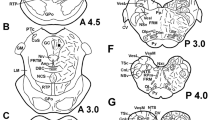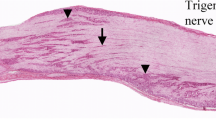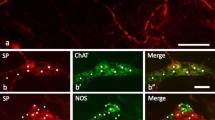Abstract
Nerve fibers and varicosities in the pelvic paracervical ganglia (PG) are immunoreactive for the neuropeptides calcitonin gene-related peptide, galanin, and the tachykinins substance P and neurokinin A. Many of these fibers and varicosities are capsaicin-sensitive, originate in dorsal root ganglia and, thus, are considered to be primary afferent fibers. Numerous immunoreactive varicosities are pericellular to principal neurons in the PG. The present study examines the ultrastructure of calcitonin gene-related peptide-, galanin-, substance P-, and neurokinin A-immunoreactive nerve fibers and varicosities in the ganglia to determine their relationships to principal neurons and their synaptic connectivity. Paracervical ganglia of female rats were processed for light-microscopic immunohistochemistry using antisera against synapsin I, as a nerve terminal marker, and microtubule-associated protein-2 to define soma and dendrites. The rationale for performing this co-immunohistochemical analysis was to reveal the relationship between nerve endings and principal neurons. Synapsin I endings were predominantly axosomatic with fewer being axodendritic. Other ganglia were processed for electron-microscopic immunohistochemistry using both standard immunogold and peroxidase-anti-peroxidase procedures. Unmyelinated fibers and varicosities immunoreactive for calcitonin gene-related peptide, galanin, and the tachykinins were routinely observed in the interstitium between neuron somas. Numerous immunoreactive axon profiles were present in small groups that were ensheathed by Schwann cells. Immunoreactive fibers and varicosities were also observed within the satellite-cell sheath of the neuron soma and often intimately associated with the membrane of the soma, somal protrusions, or with the proximal part of a dendrite. Membrane specializations, indicative of synaptic contacts, between the fibers and the principal neurons were observed. It is suggested that these peptide-immunoreactive sensory fibers and varicosities are involved in regulation of activity in the PG.
Similar content being viewed by others
References
Beckers HJM, Klooster J, Vrensen G, Lamers W (1991) Ultrastructural identification of trigeminal nerve terminals in the pterygopalatine ganglion of rats: an anterograde tracing and immunohistochemical study. Brain Res 557:22–30
Buma P (1989) Synaptic and nonsynaptic release of neuromediators in the central nervous system. Acta Morphol Neerl Scand 26:81–113
Dail WG Jr, Evan AP Jr, Eason HR (1975) The major ganglion in the pelvic plexus of the male rat. Cell Tissue Res 159:49–62
DeCamilli P, Cameron R, Greengard P (1983a) Synapsin I (protein I), a nerve terminal-specific phosphoprotein: I. Its general distribution in synapses of the central and peripheral nervous system demonstrated by immunofluorescence in frozen and plastic sections. J Cell Biol 96:1337–1354
DeCamilli P, Harris SM Jr, Huttner WB, Greengard P (1983b) Synapsin I (protein I), a nerve terminal-specific phosphoprotein: II. Its specific associationwith synaptic vesicles demonstrated by immunocytochemistry in agarose-embedded synaptosomes. J Cell Biol 196:1355–1373
Duggan AW, Hope PJ, Jarrott B, Schaible HG, Fleetwood WS (1990) Release, spread and persistence of immunoreactive neurokinin A in the dorsal horn of the cat following noxious cutaneous stimulation; studies with antibody microprobes. Neuroscience 35:195–202
Dun NJ, Mo N (1988) Calcitonin gene-related peptide evokes fast and slow depolarizing responses in guinea pig cocliac neurons. Neurosci Lett 87:157–162
Feher E, Burnstock G (1991) Ultrastructure and distribution of somatostatin-like immunoreactive neurons and nerve fibres in the coeliac ganglion of cats. Cell Tissue Res 263:567–572
Forchand CJ (1985) Density of somatic innervation on mammalian autonomic ganglion cells is inversely related to dendritic complexity and preganglionic convergence. J Neurosci 5:3403–3408
Fuxe K, Agnati L (1991) Two principal modes of electrochemical communication in the brain: volume versus wiring transmission. In: Fuxe K, Agnati L (eds) Volume transmission in the brain: novel mechanisms for neural transmission. Raven Press, New York, pp 1–9
Gibbins IL (1989) Co-existence and co-function. In: Holmgren S (ed) The comparative physiology of regulatory peptides. Chapman and Hall, London New York, pp 308–343
Groat WC de, Booth AM (1980) Inhibition and facilitation in parasympathetic ganglia of the urinary bladder. Fed Proc 39:2990–2996
Hökfelt T (1991) Neuropeptides in perspective: the last ten years. Neuron 7:867–879
Holzer P (1988) Local effector functions of capsaicin-sensitive sensory nerve endings: involvement of tachykinins, calcitonin gene-related peptide, and other neuropeptides. Neuroscience 24:739–768
Inyama CO, Hacker GW, Gu J, Dahl D, Bloom SR, Polak JM (1985) Cytochemical relationships in the paracervical ganglion (Frankenhauser) of rat studied by immunocytochemistry. Neurosci Lett 55:311–316
Inyama CO, Wharton J, Su HC, Polak JM (1986) CGRP-immunoreactive nerves in the genitalia of the female rat originate from dorsal root ganglia T11-L3 and L6-S1: a combined immunocytochemical and retrograde tracing study. Neurosci Lett 69:13–18
Jiang Z, Dun NJ, Karczmar AG (1982) Substance P: a putative sensory transmitter in mammalian autonomic ganglia. Science 217:739–741
Kanerva L, Teravainen H (1972) Electron microscopy of the paracervical (Frankenhauser) ganglion of the adult rat. Z Zellforsch 129:161–177
Kawatani M, Shioda S, Nakai Y, Takeshige C, Groat WC de (1989a) Ultrastructural analysis of enkephalinergic terminals in parasympathetic ganglia innervating the urinary bladder of the cat. J Comp Neurol 288:81–91
Kawatani M, Whitney T, Booth AM, Groat WC de (1989b) Excitatory effect of substance P in parasympathetic ganglia of cat urinary bladder. Am J Physiol 257:R1450-R1456
Keast JR (1991) Patterns of co-existence of peptides and differences of nerve fibre types associated with noradrenergic and non-noradrenergic (putative cholinergic) neurons in the major pelvic ganglion of the male rat. Cell Tissue Res 266:405–415
Kondo H, Yui R (1981) An electron microscopic study on substance P-like immunoreactive nerve fibers in the celiac ganglion of guinea pigs. Brain Res 222:134–137
Konishi S, Song S, Ogawa T, Kanazawa I (1989) Tachykinins produce fast and slow depolarizations in sympathetic neurons of rat coeliac-superior mesenteric ganglia. Brain Res 490:162–165
Kummer W (1992) Ultrastructure of calcitonin gene related peptide-immunoreactive nerve fibres in guinea-pig peribronchial ganglia. Regul Pept 37:135–142
Lee Y, Hayashi N, Hillyard CJ, Girgis S, MacIntyre I, Emson PC, Tohyama M (1987) Calcitonin gene-related peptide-like immunoreactive sensory fibers form synaptic contact with sympathetic neurons in the rat celiac ganglion. Brain Res 407:149–151
Leranth C, Feher E (1983) Synaptology and sources of vasoactive intestinal polypeptide and substance P containing axons of the cat celiac ganglion: an experimental electron microscopic immunohistochemical study. Neuroscience 10:947–958
Masuko S, Chiba T (1987) Electron microscopic studies on the organization of peptide nerve terminals in the inferior mesenteric ganglion. Exp Brain Res 16:174–179
Matthews MR, Cuello AC (1982) Substance P-immunoreactive peripheral branches of sensory nerves innervate guinea pig sympathetic neurons. Proc Natl Acad Sci USA 79:1668–1672
Matthews MR, Connaughton M, Cuello AC (1987) Ultrastructure and distribution of substance P-immunoreactive sensory collaterals in the guinea pig prevertebral sympathetic ganglia. J Comp Neurol 258:28–51
Matus A (1988) Microtubule-associated proteins: their potential role in determining neuronal morphology. Annu Rev Neurosci 11:29–44
McKeon TW, Parsons RL (1991) Microtubule-associated protein-2 and neurofilament immunoreactivity in neurons and small intensely fluorescent cells of an amphibian cardiac ganglion. Neuroscience 45:241–254
McNeill DL, Coggeshall RE, Carlton SM (1988) A light and electron microscopic study of calcitonin gene-related peptide in the spinal cord of the rat. Exp Neurol 99:699–708
Morris JL, Gibbins IL (1987) Neuronal colocalization of peptides, catecholamines, and catecholamine-synthesizing enzymes in guinea pig paracervical ganglia. J Neurosci 7:3117–3130
Morris JF, Pow DV (1991) Widespread release of peptides in the central nervous system: quantitation of tannic acid-captured exocytoses. Anat Rec 231:437–445
Murofushi H, Suzuki M, Sakai H, Kobayashi S (1989) Immunohistochemical localization of microtubule-associated proteins in the nervous system of the small intestine of guinea pig. Cell Tissue Res 255:315–322
Palmer JM, Schemann M, Tamura K, Wood JD (1986) Galanin mimics slow sympathetic inhibition in myenteric neurons. Eur J Pharmacol 124:379–380
Papka RE (1990) Some nerve endings in the female rat pelvic paracervical autonomic ganglia and varicosities in the uterus contain calcitonin gene-related peptide and originate from dorsal root ganglia. Neuroscience 39:459–470
Papka RE, McNeill DL (1991) Subpopulations of terminals in the pelvic paracervical autonomic ganglia originate from sensory ganglia. J Auton Nerv Syst 33:111
Papka RE, McNeill DL (1992) Coexistence of calcitonin gene-related peptide- and galanin-immunoreactivity in female rat pelvic and dorsal root ganglia. Peptides 13:761–767
Papka RE, Traurig HH (1987) Substance K-, substance P-, and calcitonin gene-related peptide-immunoreactive nerves in the female reproductive organs. In: Henry JL (ed) Substance P and neurokinins. Springer, Berlin Heidelberg New York, pp 229–231
Papka RE, Traurig HH (1989) Galanin-immunoreactive nerves in the female rat paracervical ganglion and uterine cervix: distribution and reaction to capsaicin. Cell Tissue Res 257:41–51
Papka RE, Traurig HH (1992) Autonomic and visceral sensory innervation of the female reproductive system: special reference to neurochemical markers in nerves and ganglionic connections. In: Maggi CA (ed) Nervous control of the urogenital system. Harwood Academic (The autonomic nervous system, vol 3) Chur, Switzerland, pp 421–464
Papka RE, Traurig HH, Westein W (1985) Localization of peptides in nerve terminals in the paracervical ganglion of the rat by light and electron microscopic immunohistochemistry: enkephalin and atrial natriuretic factor. Neurosci Lett 61:285–290
Papka RE, Yu SM, Nikitovitch-Winer MB (1986) Use of immunoperoxidase and immunogold methods in studying prolactin secretion and application of immunogold labelling for pituitary hormones and neuropeptides. Am J Anat 175:289–306
Papka RE, Traurig HH, Klenn P (1987) Paracervical ganglia of the female rat: histochemistry and immunohistochemistry of neurons, SIF cells, and nerve terminals. Am J Anat 179:243–257
Papka RE, Newton BW, McNeill DL (1991) Origin of galanin-immunoreactive nerve fibers in the rat paracervical autonomic ganglia and uterine cervix. J Auton Nerv Syst 33:25–34
Rogers H, Kennedy C, Henderson G (1990) Characterization of the neurons of the mouse hypogastric ganglion: morphology and electrophysiology. J Auton Nerv Syst 29:255–270
Saria A, Ma RC, Theodorsson-Norheim E, Lundberg JM, Skofitsch G, Amann R, Dun NJ (1987) Multiple tachykinins and calcitonin gene-related peptide (CGRP) in capsaicin-sensitive nerves of sympathetic ganglia. In: Henry JL (ed) Substance P and neurokinins. Springer, Berlin Heidelberg New York, pp 244–245
Seress L, Ribak CE (1992) Ultrastructural features of primate granule cell bodies show important differences from those of rats: axosomatic synapses, somatic spines and infolded nuclei. Brain Res 569:353–357
Shew RL, Papka RE, NcNeill DL (1991) Substance P and calcitonin gene-related peptide immunoreactivity in nerves of the rat uterus: localization, colocalization and effects on uterine contractility. Peptides 12:593–600
Smolen AJ (1988) Morphology of synapses in the autonomic nervous system. J Electron Microsc Tech 10:187–204
Sternini C, Card JP (1991) Ultrastructural characterization of calcitonin gene-related peptide-containing fibers and islet cells in the rat pancreas. Pancreas 6:375–384
Tabatabai M, Booth AM, Groat WC de (1986) Morphological and electrophysiological properties of pelvic ganglion cells in the rat. Brain Res 382:61–70
Thureson-Klein Å, Klein RL (1990) Exocytosis from neuronal large dense-cored vesicles. Int Rev Cytol 121:67–126
Traurig HH, Papka RE, Rush ME (1988) Effects of capsaicin on reproductive function in the female rat: role of peptide-containing primary afferent nerves innervating the uterine cervix in the neuroendocrine copulatory response. Cell Tissue Res 253:573–581
Verhage M, McMahon HT, Ghijsen WEJM, Boomsma F, Scholten G, Wiegant VM, Nicholls DG (1991) Differential release of amino acids, neuropeptides, and catecholamines from isolated nerve terminals. Neuron 6:517–524
Wang BR, Senba E, Tohyama M (1990) Met5-enkephalin-arg6-gly7-leu8-like immunoreactivity in the pelvic ganglion of the male rat: a light and electron microscopic study. J Comp Neurol 293:26–38
Yokota R, Burnstock G (1983) Synaptic organization of the pelvic ganglion in the guinea-pig. Cell Tissue Res 232:379–397
Zhu PC, Thureson-Klein 0A, Klein RL (1986) Exocytosis from large dense cored vesicles outside the active zones of teminals within the trigeminal subnucleus caudalis: a possible mechanism for neuropeptide release. Neuroscience 19:43–54
Author information
Authors and Affiliations
Rights and permissions
About this article
Cite this article
Papka, R.E., McNeill, D.L. Light- and electron-microscopic study of synaptic connections in the paracervical ganglion of the female rat: special reference to calcitonin gene-related peptide-, galanin- and tachykinin (substance P and neurokinin A)-immunoreactive nerve fibers and terminals. Cell Tissue Res 271, 417–428 (1993). https://doi.org/10.1007/BF02913724
Received:
Accepted:
Issue Date:
DOI: https://doi.org/10.1007/BF02913724




